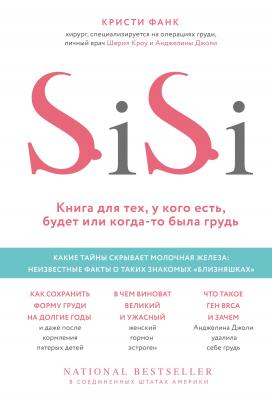SiSi. Книга для тех, у кого есть, будет или когда-то была грудь. Кристи Фанк
Читать онлайн.| Название | SiSi. Книга для тех, у кого есть, будет или когда-то была грудь |
|---|---|
| Автор произведения | Кристи Фанк |
| Жанр | Медицина |
| Серия | Красота в деталях. Научный подход к женскому здоровью |
| Издательство | Медицина |
| Год выпуска | 2018 |
| isbn | 978-5-04-099400-7 |
126
N. Guha et al., “Soy Isof lavones and Risk of Cancer Recurrence in a Cohort of Breast Cancer Survivors: The Life after Cancer Epidemiology Study,” Breast Cancer Research and Treatment 118, no. 2 (2009): 395–405.
127
P. J. Magee and I. R. Rowland, “Phyto-oestrogens, Their Mechanism of Action: Current Evidence for a Role in Breast and Prostate Cancer,” British Journal of Nutrition 91, no. 4 (2004): 513–531; L. Varinska et al., “Soy and Breast Cancer: Focus on Angiogenesis,” International Journal of Molecular Sciences 16, no. 5 (2015): 11728–11749.
128
F. F. Zhang, et al., “Dietary Isof lavone Intake and All‐Cause Mortality in Breast Cancer Survivors: The Breast Cancer Family Registry,” Cancer 123, no. 11 (2017): 2070–2079.
129
X. O. Shu et al., “Soy Food Intake and Breast Cancer Survival,” Journal of the American Medical Association 302, no. 22 (2009): 2437–2443.
130
S. J. Nechuta et al., “Soy Food Intake after Diagnosis of Breast Cancer and Survival: An In-Depth Analysis of Combined Evidence from Cohort Studies of US and Chinese Women,” The American Journal of Clinical Nutrition 96, no. 1 (2012): 123–132.
131
F. Chi et al., “Post-Diagnosis Soy Food Intake and Breast Cancer Survival: A Metaanalysis of Cohort Studies,” Asian Pacific Journal of Cancer Prevention 14, no. 4 (2013): 2407–2412.
132
Economic Research Service, “Recent Trends in GE Adoption,” United States Department of Agriculture, последнее обновление 12 июля 2017 года, http://www.ers.usda.gov/data-products/adoption-of-genetically-engineered-crops-in-the-us/recent-trends-inge-adoption.aspx.
133
J. A. Miller et al., “Human Breast Tissue Disposition and Bioactivity of Limonene in Women with Early-Stage Breast Cancer,” Cancer Prevention Research 6, no. 6 (2013): 577–584.
134
U. Veronesi et al., “Randomized Trial of Fenretinide to Prevent Second Breast Malignancy in Women with Early Breast Cancer,” Journal of the National Cancer Institute 91, no. 21 (November 1999): 1847–1856.
135
S. Gandini et al., “Meta-analysis of Studies on Breast Cancer Risk and Diet: The Role of Fruit and Vegetable Consumption and the Intake of Associated Micronutrients,” European Journal of Cancer 36, no. 5 (March 2000): 636–646.
136
S. M. Zhang et al., “Plasma Folate, Vitamin B6, Vitamin B12, Homocysteine, and Risk of Breast Cancer,” Journal of the National Cancer Institute 95, no. 5 (March 2003): 373–380.
137
S. Gandini, “Meta-analysis of Studies on Breast Cancer Risk and Diet: The Role of Fruit and Vegetable Consumption and the Intake of Associated Micronutrients,” European Journal of Cancer 36, no. 5 (March 2000): 636–646.
138
M. S. Donaldson, “Metabolic Vitamin B12 Status on a Mostly Raw Vegan Diet with Follow-up Using Tablets, Nutritional Yeast, or Probiotic Supplements,” Annals of Nutrition and Metabolism 44, no. 5–6 (2000): 229–234.
139
S. J. P. M. Eussen et al., “Oral Cyanocobalamin Supplementation in Older People with Vitamin B12 Deficiency: A Dose-Finding Trial,” Archives of Internal Medicine 165, no. 10 (2005): 1167–1172.
140
A. J. L. Cooper, “Biochemistry of Sulfur-Containing Amino Acids,” Annual Review of Biochemistry 52 (1983): 187–222; J. D. Hayes and L. I. McLellan, “Glutathione and Glutathione-Dependent Enzymes Represent a Co-ordinately Regulated Defence against Oxidative Stress,” Free Radical Research 31 (1999): 273–300.
141
S. M. Zhang et al., “Plasma Folate, Vitamin B6, Vitamin B12, Homocysteine, and Risk of Breast Cancer,” Journal of the National Cancer Institute 95, no. 5 (2003): 373–380.
142
J. K. Song and J. M. Bae, “Citrus Fruit Intake and Breast Cancer Risk: A Quantitative Systematic Review,” Journal of Breast Cancer 16, no. 1 (2013): 72–76.
143
G. R. Howe et al., “Dietary Factors and Risk of Breast Cancer: Combined Analysis of 12 Case-Control Studies,” Journal of the National Cancer Institute 82, no. 7 (1990): 561–569.
144
K. Robien, G. J. Cutler, and D. Lazovich, “Vitamin D Intake and Breast Cancer Risk in Postmenopausal Women: The Iowa Women’s Health Study,” Cancer Causes and Control 18, no. 7 (September 2007): 775–782.
145
C. F. Garland et al., “Vitamin D and Prevention of Breast Cancer: Pooled Analysis,” Journal of Steroid Biochemistry and Molecular Biology 103, nos. 3–5 (March 2007): 708–711.
146
S. B. Mohr et al., “Meta-analysis of Vitamin D Sufficiency for Improving Survival of Patients with Breast Cancer,” AntiCancer Research 34, no. 3 (2014): 1163–1166.
147
C. F. Garland et al., “Vitamin D and Prevention of Breast Cancer: Pooled Analysis,” Journal of Steroid Biochemistry and Molecular Biology 103, nos. 3–5 (March 2007): 708–711.
148
C. F. Garland et al., “Vitamin D Supplement Doses and Serum 25-Hydroxyvitamin D in the Range Associated with Cancer Prevention,” AntiCancer Research 31, no. 2 (2011): 607–611.
149
E. Kesse-Guyot et al., “Dairy Products, Calcium, and the Risk of Breast Cancer: Results of the French SU.VI.MAX Prospective Study,” Annals of Nutrition and Metabolism 51, no. 2 (2007): 139–145; M. L. McCullough et al., “Dairy, Calcium, and Vitamin D Intake and Postmenopausal Breast Cancer Risk in the Cancer Prevention Study II Nutrition Cohort,” Cancer Epidemiology, Biomarkers and Prevention 14, no. 12 (December 2005): 2898–2904.
150
P. W. Parodi, “Dairy Product Consumption and the Risk of Breast Cancer,” Journal of the American College of Nutrition 24 (2005): 556S–5568S; Y. Cui and T. E. Rohan, “Vitamin D, Calcium, and Breast Cancer Risk: A Review,” Cancer Epidemiology, Biomarkers and Prevention 15, no. 8 (2006): 1427–1437.
151
B. C. Davis and P. M. Kris-Etherton, “Achieving Optimal Essential Fatty Acid Status in Vegetarians: Current Knowledge and Practical Implications,”
